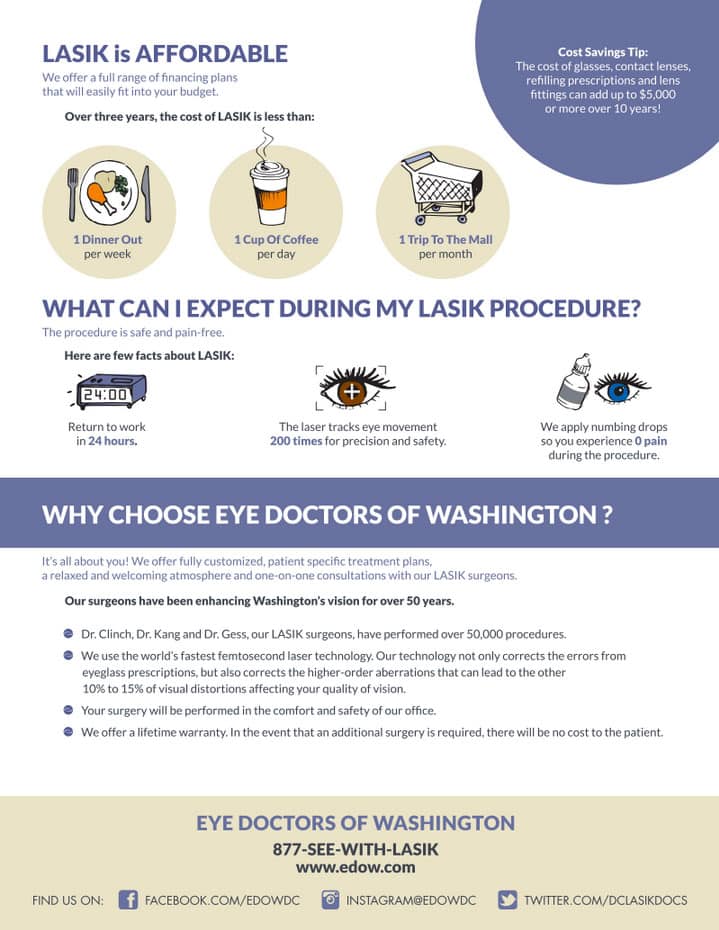Exactly How Does SMILE Eye Surgical Procedure Contrast To LASIK And PRK?
Exactly How Does SMILE Eye Surgical Procedure Contrast To LASIK And PRK?
Blog Article
Staff Author-Dreyer Wilder
If you've been thinking about SMILE eye surgery, you may ask yourself just how it compares to LASIK and PRK. Each treatment has its own collection of benefits and considerations. From Eye Surgery Lv to possible dangers, there are key differences you should understand before deciding. Recognizing these distinctions will certainly help you make an informed option that aligns with your specific demands and expectations. Curious to recognize more regarding how these procedures contrast carefully? Keep checking out to obtain a detailed understanding of SMILE, LASIK, and PRK.
SMILE Eye Surgery Review
If you're considering SMILE eye surgical procedure, you'll find it to be a minimally invasive treatment with a fast recuperation time. During SMILE (Tiny Incision Lenticule Extraction), a laser is utilized to create a small, precise cut in the cornea to get rid of a tiny piece of cells, reshaping it to fix your vision. This varies from LASIK, where a flap is developed, and PRK, where the outer layer of the cornea is totally gotten rid of.
One of the crucial benefits of SMILE is its minimally intrusive nature, leading to a faster healing process and less pain post-surgery. The healing time for SMILE is relatively quick, with many clients experiencing boosted vision within a day or two. This makes it a preferred selection for those looking for a practical and reliable vision correction treatment. In Eye Surgery Cost , SMILE has actually been revealed to have a reduced danger of completely dry eye syndrome contrasted to LASIK, making it a beneficial choice for people concerned about this possible adverse effects.
Distinctions In Between SMILE, LASIK, and PRK
When comparing SMILE, LASIK, and PRK eye surgeries, it is essential to understand the distinct methods utilized in each treatment for vision improvement.
SMILE (Tiny Incision Lenticule Removal) is a minimally intrusive treatment that involves creating a little incision to draw out a lenticule from the cornea, reshaping it to deal with vision.
LASIK (Laser-Assisted Sitting Keratomileusis) includes developing a thin flap on the cornea, making use of a laser to reshape the underlying tissue, and afterwards rearranging the flap.
PRK (Photorefractive Keratectomy) eliminates the outer layer of the cornea before reshaping the cells with a laser.
The major distinction hinges on the means the cornea is accessed and dealt with. SMILE is flapless, making it a great option for people with thin corneas or those associated with contact sporting activities. are cataract surgery provides rapid aesthetic recovery because of the flap production, yet it may pose a higher risk of flap-related issues. PRK, although having a longer recovery period, stays clear of flap-related issues completely.
Comprehending these variances is crucial in selecting one of the most suitable treatment for your vision modification demands.
Advantages And Disadvantages Comparison
To review the advantages and disadvantages of SMILE, LASIK, and PRK eye surgeries, it's essential to consider the specific benefits and potential limitations of each treatment. SMILE surgical treatment uses the advantage of a minimally intrusive procedure, with a smaller cut and potentially quicker recuperation time compared to LASIK and PRK. It likewise reduces the risk of completely dry eye post-surgery, a common adverse effects of LASIK. However, SMILE might have limitations in dealing with greater levels of myopia or astigmatism contrasted to LASIK.
LASIK surgical treatment offers quick visual healing and very little pain during the procedure. It's extremely efficient in dealing with a vast array of refractive errors, consisting of nearsightedness, hyperopia, and astigmatism. Yet, LASIK lugs a risk of flap issues, which can affect the corneal structure.
PRK eye surgical procedure, while not as popular as LASIK, avoids producing a corneal flap, lowering the danger of flap-related problems. https://www.dovepress.com/a-randomized-fellow-eye-clinical-trial-to-evaluate-patient-preference--peer-reviewed-fulltext-article-OPTH appropriates for people with thin corneas or uneven corneal surface areas. However, PRK has a longer recovery time and might involve a lot more pain during the recovery process.
Verdict
So, when it involves selecting between SMILE, LASIK, and PRK, think about it like selecting the excellent set of shoes. SMILE is like a smooth, comfortable pair of tennis shoes - fast and simple.
LASIK is extra like fashionable high heels - flashy and fast, but with some potential risks.
PRK is like sturdy treking boots - dependable and sturdy, yet needing a bit even more time and effort.
Inevitably, the very best selection depends upon your individual requirements and preferences.
